#bob theil
Explore tagged Tumblr posts
Text
Bob Theil - So Far, 1982. 🏴
#bob theil#jim covington#james litherland#jed marchant#bill power#mark brzezcki#steve hall#1982#not on a label#guerssen records#vibratorysounds#eclecticmud
0 notes
Photo
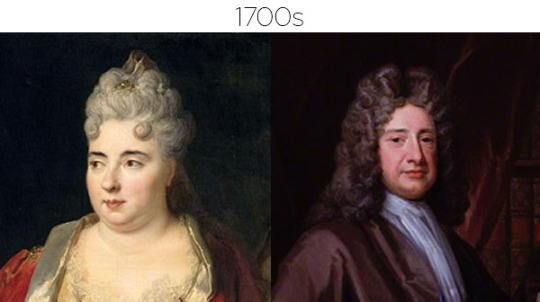
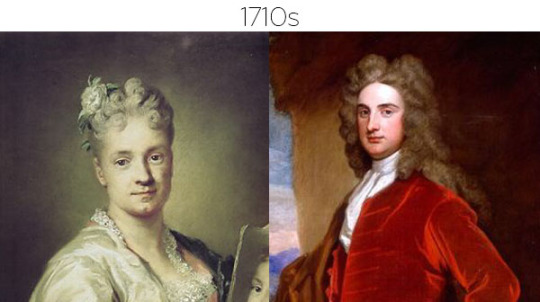

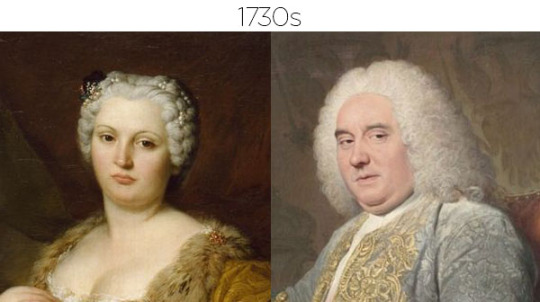
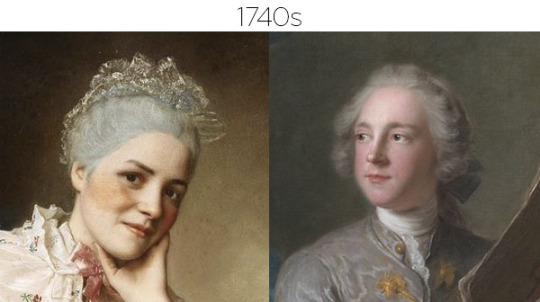
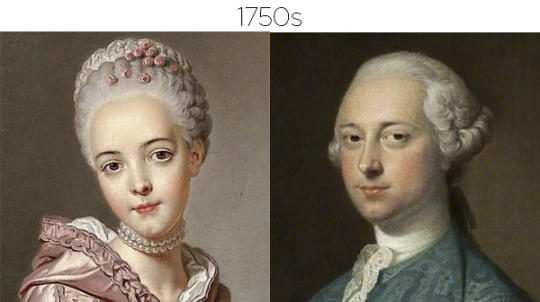
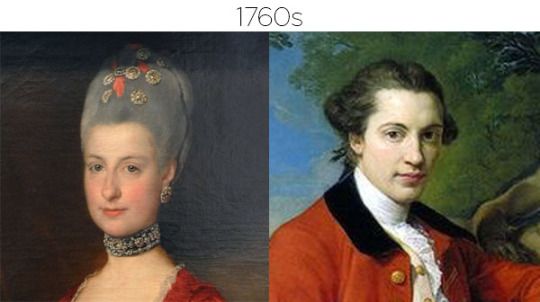
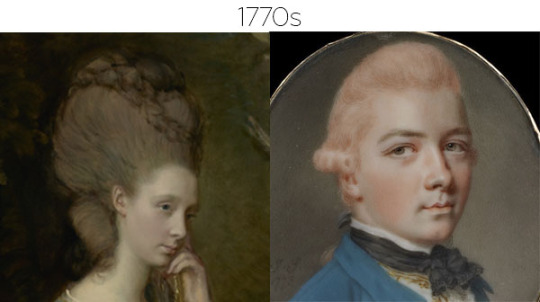

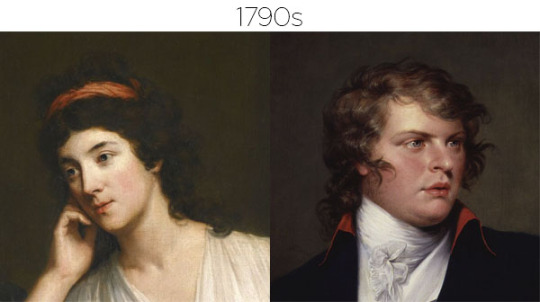
Hairstyles of the 18th Century
As requested, here’s a simple and quite basic timeline of hairstyle during the 18th century. It is mostly eurocentric, because most of fashion moved from Europe (especially France) to the rest of the world (even if a style was not originated there).
I thought to give you all a glimpse into the main changes of the century, of how hairstyling and wigs changed through the years, and how different the looks from the early century are from the ones of the late century: how we can see the change from the Baroque to the Regency era, and the rise and fall of the Rococo style.
So, in the images above, you can see a detail of a portrait of woman and a man from each decade of the century, starting in the 1700s and ending with the 1790s. Of course there are several examples for each decade, but I chose to use just two as a way of simplifying. But you can see the full paintings and more references in this Pinterest board I made.
I like to divide the century style in four parts just because that’s how I get it better: early, mid and late century, and the turn of the century. And of course each with its own cute little subtitle.
EARLY 18TH CENTURY a.k.a. fuck yeah the Baroque is still here (1700s-1730s)
WOMAN - For the late 17th century and early 18th century, the key hairstyle is the fontange, or top-knot in England, which is a hairstyle with the front hair piled up high, and in the late 17th century accompanied by a lace hairddress that could reach quite interesting heights. The hairstyles we see in the portraits above, are fontanges, but the frelange headdress got smaller and smaller until it disappeared.
The hair lost height until the 1720s, when low, simple hairdos took place, but the curls were not lost, they just turned into the tête de mouton.
MAN - the full bottomed wig is THE wig of the early 18th century, with its fluffy curls in natural colours or white, almost waist length and middle parted. This style was originated by Louis XIII in 1624, when he lost his hair it turned from the natural hair to wigs for everyone, since such volume is hard to achieve and keep. So, more is more. This style was worn pretty much until the 1730s.
During this time we see the emergence of the bag wig in the 1720s (the hair was tied at the back and then put in a small black bag, curls were made over the ears), and the bob wig (hair falling just below the ears, it had curls or a simple frizz all over) begins to be worn in the 30s
MID 18TH CENTURY a.k.a. never enough curls /1740s-1750s)
WOMEN - During this time, the hair was worn in soft waves with little or no height, and in the back it was arranged in small curls, a twist or a braid pinned to the head. But, if you could encapsulate THE hairstyle of the mid century, it would be the tête de mouton, with its close-fitted style of curls in neat rows, and the powdered with white powder (remember this look from Marie Antoinette?). This style was immortalised by Madame de Pompadour, and with her dead in 1764, this style went out of fashion for the sky-high styles of the rococo.
MAN - From the 40s-60s, the hair became bigger, the Ramillies wig (tied the hair in a plait at the back) came into fashion (even though it existed before, and was prefered by military men) with its tie in the back and the curls over the ears, which became THE mens hairstyle for the 18th century, or at least the one we all easily recognise.
LATE 18TH CENTURY a.k.a. we do not know the limits of things anymore (1760s-1780s)
WOMEN - During the 1760s, the high styles began to appear, being about 1/4 or 1/2 the length of the face. It was styled in an egg shape and was pretty much simple with the styling with a few decorations. But oh, the 1770s came, and HUGE hair became all the rage, going to 1 1/2 times the length of the face, styled in the shape of an air balloon. To achieve the height cushions or toques were used: attached to the top of the head, then the hair (natural or false) was curled, waved, or frizzed, and piled over the cushion, the back of the hair was set in curls and angled towards the back of the hair, and then decorated with all kinds of things. And I mean that, all kinds of things: from bows and ribbons to ships and bird cages. These styles were worn for days or weeks at a time, and were styled into allegories of current events (vaccinations? done! air balloon? done! zodiac? done!). This style was called pouf, pouffe, or toque.
In the 1780s the volume became horizontal, instead of vertical, and out very favourite hedgehog style, or coiffure à l’enfant, was born: a halo of of frizzy curls around the face, a small hank of longer hair left straight or in ringlets. The name coiffure à l’enfant was given by Marie Antoinette’s coiffeur Léonard Autie, when she gave birth to the dauphin and she lost a lot of hair and he made this hairstyle for her (which she wears in her portrait by Louis Elisabeth Vigée-LeBrun wearing a chemise à la reine). But, like a lot in fashion, the style can be seen a few years earlier, so it’s likely that that was just the same that stuck. Even though the style of the 1780s was supposed to be more natural, the hedgehog could be really REALLY big, and fake hair was used to achieve that volume.
MEN - Men’s hair went up as well, not as high as women’s BUT certainly higher. We see the volume of the pouffe in men’s hair at the top of the head, with pigeon wings (curls over the ears) and the rest of the hair tied in the back. This is the clear origin of the 1950s Pompadour hairstyle. Power was all the rage in many colours, and wigs were desirable in white or grey, but natural colours were accepted as well, just need to powder it.
TURN OF THE CENTURY (1790s-1800s) a.k.a. oh shit, that was too much! Let’s get minimal
WOMEN - After French Revolution powder went out of fashion in France, and in England it happened in 1795 when it was taxed even though it was already used less and less. This was the start of what we know as Regency fashion, which was an absolute contrast of the silhouettes worn in most of the century. Ad hair was not different.
The hedgehog was still worn, but the volume became more natural, and the hair was decorated simply with ribbons. Another style was the hair being worn in ringlets framing the face in a more restrained way, and a chignons in the back, showing off the neck. The hair could also be cut short, like very famously Lady Caroline Lamb did, ina a style called à la Titus, that became fashionable for men and women. Very Jane Austen-esque. The colours were natural with the powder gone, and this was the beginning of the Romantic period.
MEN - The powder was out of fashion, so no more white, grey or colourful hair for men. With the discovery of Pompeii’s ruins, we see a renaissance for classical and hellenic references during the 18th century, and we see that in women’s white fashions and curls, inspired in Greek and Roman sculptures, and in men we see short hair for the first time in a LONG time, inspired by ancient senators and gods. In 1795 with the powder tax, men potested cutting their hair (I mean, no hair, no need for powder), and we see the rise of the Bedford crop (a short cropped hairstyle with curls, parted to the side, styled with wax), started by the Duke of Bedford and then followed by his friends.
The layered short curly hairstyle called à la Titus, became famous while being worn by actor François-Joseph Talma as Titus Junius Brutus in Voltaire’s “Brutus”, shocking audiences with his short natural hair, also known as the Brutus hairstyle.
Formal court dress still required a powdered wig, as well as some professions and older and military men. But, by 1812 the age of the wig was gone.
_________________________________________________________________
FINAL NOTES: If you’re using this a guide for writing/art or a reference for how to style your hair, remember that these dates are not absolute, and that the beginnings and endings of the decades have a lot of mixing styles. So, for example, you can still have a hedgehog style in the 1790s, even though it was not THE hairstyle of the decades, and of course the portraits of the time clearly show this.
Images, from top:
Marie-Anne Mancini, duchesse de Bouillon (présumé) , ca. 1700, Nicolas de Largillière.
Sir John Chardin, ca. 1703, Unknown Artist.
Self-Portrait with sister, 1715, Rosalba Carriera.
Sir John Rushout, 4th Baronet, 1716, Sir Godfrey Kneller.
Madame Isaac de Thellusson, née Sarah le Boullenger, 1725, Nicolas de Largillière.
Portrait of Léopold Clément, Hereditary Prince of Lorraine, ca. 1720, Pierre Gobert.
Portrait of Giovanna Bagnara, 1739, Pierre Subleyras.
Portrait of Jean-Gabriel du Theil, 1738-1740, Jacques André Joseph Aved.
Mademoiselle Louise Jacquet”, 1748-1752, Jean-Étienne Liotard.
Francis Greville, Baron Brooke, later 1st Earl of Warwick, 1741, Jean-Marc Nattier.
Portrait of a Girl Holding a Spaniel, 1750s, by Alexander Roslin.
Sir Henry Oxenden, ca. 1755, Thomas Hudson.
Maria Christina, Duchess of Teschen, 1766, Marcello Bacciarelli.
Portrait of Edmund Rolfe, 1761, Pompeo Batoni.
Portrait of Anne, Countess of Chesterfield 1777 - 1778, Thomas Gainsborough.
A Young Man, presumed to be ‘John Bertram’, 1773, John Smart
A Lady, 1785, John Smart.
Jean-Joseph Mounier, 1789, Jean-François Favre.
Portrait of a Lady, 1790s, Hugh Douglas Hamilton.
Portrait of Prince Augustus Frederick, Duke of Sussex, 1798, Guy Head.
#hairstyle#18th century#hair#hair and makeup#wigs#womens hairstyle#mens hairstyle#1700s#1710s#1720s#1730s#1740s#1750s#1760s#1770s#1780s#1790s#1800s#georgian#regency#french revolution
1K notes
·
View notes
Note
🤣The sex montage after Bobby died🙈,Sutter had to put Juice being raped among the sex scenes,he is a sick dude,sorry!Jax pounding and the screen fading into Gemma being pounded🙈,wasn’t Wendy using a vibrator??lol the only good thing was the song,which is beautiful,and fitted J/T and Jax having the saddest fuck of his life💅🏽,sorry bud😂Nero wasn’t as good as people make him look,Jimmy is charismatic but Nero really was like Wendy,they let the Tellers screw them up over and over and they always forgive them,there is a moment in s7 where Lin threats Nero’s son and Jax is like you have to pick a side on this war,I mean what an ass,and Nero still picks Jax’s side🙅🏽♀️
And it was the opening scene?? Like what the fuck?? Seriously! Juice being raped was so unsettling and disturbing, especially when it’s in a montage of consensual sex. What a sick fuck. I never noticed that until someone said it!! Like what the fuck! Why would you put those scenes right after one another 🤨?? Why would you have the son banging and than fade into his mother banging 🤮. Lol yes Wendy was using the vibrator, which also felt like a joke at Wendy’s expense?? Idk maybe it’s just me lol. The song was great! Honestly I can hate on SOA, but the music was always good! I can’t hate Bob Theile! Yes! It’s nothing againsf Jimmy, he’s a great actor. He’s been in so much, but I’m a Dexter fan and he was great in that! It’s just Sutter’s shitty writing, Nero was just so annoying. He does that shit all season, like that’s your kid dude??? And this is the guy Jax trusts his sons with?? He knows the club is going to fuck him over, they proceed to fuck him over, he bitches about it, but he doesn’t do anything! That’s his whole arc! He constantly did the same thing! Like I’m supposed to feel bad for this character?? He was just written to be the designated Gemma ass kisser, as if her ass wasn’t be kissed enough 🙄
3 notes
·
View notes
Text
Snake Creek State Recreation Area, South Dakota – Kadoka, South Dakota, Sonntag, 17. Mai 2009
Kapitel 12: Reise vom Running Water River bis Fort Pierre am Teton River (Little Missouri) und Aufenthalt daselbst vom 13. Mai bis zum 4. Juni 1833
Wied: Am 17. Mai früh sah man die ersten Antilopen, ein Rudel von sechs Stück über die Hügel entfliehen, leider waren sie zu fern, um sie deutlich unterscheiden zu können; allein später ward uns diese Freude, indem ein solches Thier an den Uferhöhen so lange stehen zu bleiben so gefällig war, bis wir dasselbe recht deutlich und nahe betrachtet hatten. Da man bei der Sondirung des Fahrwassers nur vier Fuss Tiefe gefunden hatte, so wurde das Dampfschiff an dem Weidenufer befestigt, und wir griffen zu den Jagdgewehren. Man arbeitete sich durch die dichten Ufergebüsche von Pappeln und Weiden hindurch, wo man die grossen Fährten der Elke, so wie der virginischen Hirsche kreuz und quer im weichen Boden abgedrückt fand, und trat in die Prairie, die sich vollkommen eben 300-400 Schritt weit bis zu den Hügeln ausdehnte. Der Abend war sternhell und kühl. Am 18. Mai erblickten wir die ersten Bisonsthiere, die uns auf dieser Reise vorgekommen. Mehre Jäger wurden sogleich an’s Land gesetzt, um sie zu verfolgen. Sie stiegen in einer Schlucht hinauf und verschwanden hinter den Höhen. Auch wir begaben uns an’s Land bei einer Temperatur von 68° am Mittage. Mit uns übrigen kehrten auch die Bisonjäger auf das Schiff zurück. Sie hatten zwar ihren eigentlichen Endzweck verfehlt, dagegen aber einen starken Cabri-Bock erlegt, so wie einen ganzen Haufen von Prairie-Dogs, deren Köpfe sämmtlich von der Büchsenkugel zerstört waren. Da sich diese kleinen Thiere bei Annäherung eines fremdartigen Gegenstandes in ihre Höhlen zurück ziehen, und alsdann nur mit dem Kopfe hervor blicken, so schiessen sie die Americaner mit ihren langen Büchsen meistens gerade auf diesen Theil. Sie essen sie übrigens sehr gern. Von der Antilope, welche sie auf der Stelle zerlegt hatten, brachten sie die Haut und den Kopf, sowie das Fleisch zurück. Sie lieferten ausserdem einen schönen grossen Adler und eine Natter ab. Da das Wasser des Flusses so seicht war, so konnten wir am nächstfolgenden Tage (19. Mai) unsere Stelle nicht verlassen, und unsere Excursionen wurden fortgesetzt. Des Wassermangels wegen blieben wir mehre Tage hier liegen und hatten einige heftige Gewitterstürme auszuhalten. Am 21. Mai war es so kühl, dass man im Schiffe Kaminfeuer anzündete. Der Fluss war etwas gewachsen und man versuchte fort zu schiffen.
Wir stehen hier also auf einem amerikanischen Campingplatz, umringt von Riesenwohnwagen und ihren weißen amerikanischen Besitzern. Warum ich das erwähne? Ganz einfach. Auf den Campingplätzen haben wir bisher nur weiße US-Amerikaner gesehen, keine Asiaten, keine Latinos, keine Schwarzen und erst recht keine Roten. Das Wetter ist okay, die Temperatur angenehm, der Himmel blau bis auf ein paar Cirrostratus. Die Nacht unter der neuen Zudecke war angenehm, obwohl es immer noch ziemlich kalt war. Zwar nicht so wie die Nacht davor, aber immer noch kalt genug, um sich den Arsch abzufrieren. Meine Aufmerksamkeit erregt ein Elektroroller für Kinder. Das Kind muss nicht mehr Anschwung geben, sondern braust mit Batterieantrieb durch die Gegend. Meine Reisebegleiterin klärt mich auf: Diese E-Technik kommt auch bald nach Deutschland. Wahrscheinlich liegt sie damit sogar richtig. Auf unserem iPhone läuft gerade in Bob Dylan’s “Theme Time Radio Show”: „Enjoy yourself, it’s later than you think“ von Guy Lombardo.
10.15 Uhr. Da die Yellowstone mit Wieds Reisegruppe an Bord in den nächsten Tagen nicht von der Stelle kam, bleibt uns Zeit für Exkursionen in die Rosebud Indian Reservation, in die Black Hills sowie in die Pine Ridge Indian Reservation. Let’s go to the West. Nach einem letzten Blick auf die niedliche Wayside Chapel, einer kleinen Holzkirche am Ufer des Lake Francis Case und auf die wenigen auf dem Wasser rumschippernden Boote, überqueren wir den Missouri River auf dem South Dakota Highway 44 über die Platte-Winner Bridge. Tschüss, in einer Woche sind wir wieder da.
Die Hügellandschaft bis zur Höhe ist sanft ansteigend und teilweise dicht bewaldet. Der Blick in die Weiten des Westens ist imposant. In weiter Ferne sehen wir nördlich des Highway 44 immense Tafelberge einer mächtigen Hügelkette. Im Tal tauchen die ersten Felder auf, auch die Farmen werden von Meile zu Meile immer größer. Bald darauf fahren wir durch eine grüne friedvolle Prärielandschaft, hübsch anzusehen. Der Straßenbelag ist leicht rötlich, die Straße wenig befahren. Eine Zeitlang fährt ein Auto hinter uns her, überholt uns irgendwann. Außerdem kommen uns noch zwei Wohnwagen entgegen, ansonsten ist hier null Verkehr. Noch 21 Meilen bis Winner, South Dakota. In Richtung Westen fährt auf dem schnurgeraden Highway kein Mensch. Für die Landschaft fällt mir nur eine etwas platte Beschreibung ein: Weite. Weite. Weite.
Winner ist eine Kleinstadt im Tripp County im Süden des US-Bundesstaates South Dakota. Das Tripp County ist wiederum der größte Viehproduzent in South Dakota. Mit um die 3000 Einwohnern ist Winner die größte Stadt in dieser überwiegend landwirtschaftlich geprägten Region und daher auch als Einkaufs- und Schulstadt von Bedeutung. Winner ist nicht nur wegen der Fasanenjagd bekannt, auch Hirsche, Truthähne, Präriehunde, Moorhühner, Präriehühner, Tauben und Kojoten werden in diesem Gebiet gejagt. Etwa zwei Kilometer nordöstlich des Zentrums lieg der Winner Regional Airport. Die bekanntesten Sehenswürdigkeiten von Winner sind das Baseball Leahy Bowl und das Winner Drive-In Theatre. In Winner decken wir uns erst einmal für die weitere Fahrt ein: Benzin, Kaffee, Gebäck. Interessanterweise gibt es hier eine Solarbahn und ein Holiday Inn Express. Zwei Indianer schlendern die Hauptstraße entlang.
Nun geht’s durch Marlboro Country. Pferde, Rinder und Kühe grasen auf sattgrünen Wiesen und erfreuen sich noch ihres Lebens. Die Bullen strotzen vor Kraft. Bäume und Sträucher sind verschwunden, wir fahren durch Weideland und Getreidefelder. Entlang des Highways sind erstaunlich viele Autoschrottplätze. Zur Rechten passieren wir leicht hügelige Erhebungen, die teilweise abgeflacht sind wie ein Tafelberg.

Foto: Marlboro Country
Carter, South Dakota ist ein kleines Nest im Tripp County und liegt direkt an der US-Route 18 westlich von Winner. Die Ansiedlung wurde 1909 gegründet und wahrscheinlich nach einem Landagenten benannt.
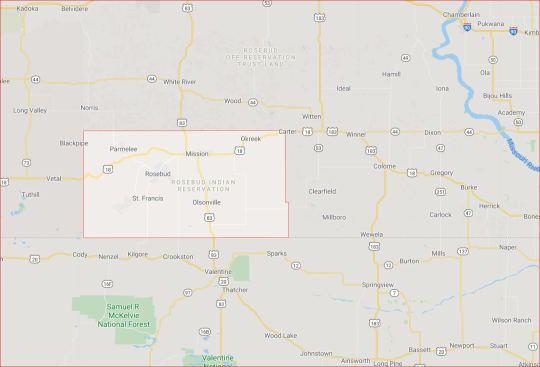
Die Rosebud Indian Reservation (Lakota Sicangu Oyate) ist ein Indianerreservat im US-Bundesstaat South Dakota. Ursprünglich Teil der Great Sioux Reservation, wurde es 1889 vom US-Kongress aus diesem herausgelöst und vom Bureau of Indian Affairs als eigenes Reservat geführt. Es umfasst die gesamte Fläche vom Todd County. Das Reservat wird von Brulé-Lakota-Indianern bewohnt. Die Fläche des Reservats einschließlich der angeschlossenen Gebiete beträgt 5103 km² und grenzt im Süden an den Bundesstaat Nebraska und im Westen an die Pine Ridge Reservation. Der Verwaltungssitz des Reservats befindet sich in der gleichnamigen Siedlung Rosebud, dort befinden sich auch Stützpunkte des Indian Health Service, des Bureau of Indian Affairs, der Tribal BIA Police und des BIA Fire Managements. Der Name Rosebud kommt von den wilden Rosen, die in der Gegend wachsen. Die größte Gemeinde des Reservats ist Mission. Auf dem Reservats-Gebiet befindet sich an der Grenze zu Nebraska auch das Rosebud Casino, das eines der größten Arbeitgeber des Reservats ist. Die Situation im Reservat kann nur als hoffnungslos bezeichnet werden: 80% der arbeitsfähigen Bevölkerung sind arbeitslos, die durchschnittliche Lebenserwartung für männliche Bewohner beträgt nur lausige 47 Jahre und die Selbstmordrate im Reservat liegt 400 % über dem Landesdurchschnitt. Etwa die Hälfte der Bevölkerung über 40 Jahre leidet an Diabetes, die Rate der an Tuberkulose Erkrankten ist 8 Mal höher als im Landesdurchschnitt und die Anzahl der Bevölkerung mit Alkohol- und Drogenproblemen wird auf fast 70 % geschätzt. Nur 10 % der Schüler der Todd County Highschool schaffen einen Abschluss.
Im Jahr 1868 entstand durch den zweiten Vertrag von Fort Laramie das Great Sioux Reservat. Dieser Vertrag legte das Gebiet des gesamten heutigen US-Bundesstaates South Dakota westlich des Missouri, einschließlich der Black Hills (von der Nordgrenze in Nebraska bis zum 46. Breitengrad und vom Missouri im Osten bis zum 104. Meridian im Westen) als Indianer-Land zur uneingeschränkten und unbehelligten Nutzung und Besiedlung durch die Great Sioux Nation fest. Dem Vertrag vorausgegangen war der Red-Cloud-Krieg (1866–1868), ein Krieg, der einen vollständigen Sieg der Lakota bedeutete. Deswegen waren die Sioux-Indianer in einer guten Verhandlungsposition und konnten ein großes Gebiet im heutigen South Dakota für sich beanspruchen. Da das Gebiet von mehreren Indianerstämmen besiedelt wurde, errichtete man mehrere Stützpunkte des Bureau of Indian Affairs (BIA) im Reservatsgebiet.
Das heutige Reservat hat seine Ursprünge in der Whetstone Indian Agency, einem Stützpunkt des BIA, der für die Brulé-, Oglala- und Miniconjou-Sioux zuständig war. Gegründet 1869, zog die Agentur mehrmals um, 1871 an den Big White Clay Creek und 1875 an den White River im Grenzgebiet zwischen dem Nebraska und dem Dakota-Territorium. 1978 wurde die Spotted Tail Indian Agency aus der Whetstone Indian Agency herausgelöst und als eigene Agentur geführt, die später an den Rosebud Creek in South Dakota umzog. Im gleichen Jahre wurde die Agentur in Rosebud Agency umbenannt. Zur gleichen Zeit erhielten die Oglala-Sioux auch ihre eigene Agentur, die Red Cloud Agency, dem heutigen Pine Ridge.
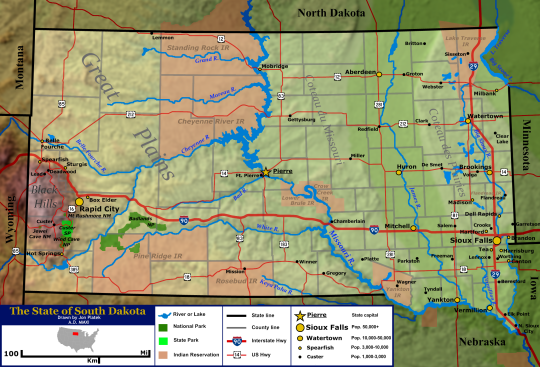
Die Black Hills gelten den Lakota-Sioux als heilige Berge. Zudem stellen sie den Gegenstand zahlreicher Mythen der Lakota dar. Noch heute besuchen einige Stammesangehörige die spirituellen Orte in den Bergen, um ihre Religion auszuüben. Ursprünglich waren sie Teil der Great Sioux Reservation. Eine nach dem Vertrag illegale Expedition unter George Armstrong Custer erkundete 1874 die Black Hills und fand in den Bergen Gold. Nach den Goldfunden versuchte die Regierung, die Lakota zu einer Abtretung der Bergkette zu bewegen, allerdings ohne Erfolg. Goldsucher drangen rechtswidrig in das Gebiet ein, der Goldrausch kannte keine Grenzen mehr. Konflikte im Winter 1875/76 führten zum erneuten Einsatz Custers und des 7. Kavallerie-Regiments und der Schlacht am Little Bighorn im Juni 1876. Nach der endgültigen Niederlage der Indianer im Herbst desselben Jahres wurden 1877 die Black Hills den Sioux entzogen. Dieses Gesetz der Bundesregierung wird von der Rosebud Reservation bis heute nicht anerkannt, da die erforderlichen 3/4 der männlichen Bewohner dem Vertrag nicht zugestimmt haben. Dies war aber nach dem Vertrag von Fort Laramie 1868 vorgeschrieben.
Ursprünglich war das Reservat Teil der Great Sioux Reservation, bevor es am 2. März 1889 in kleinere Reservate aufgeteilt wurde und aus der Agentur ein eigenständiges Reservat entstand. Dabei gingen den Indianern 36000 Quadratkilometer verloren. Rosebud war aber davon nicht direkt betroffen und umfasste weiterhin die Gebiete der heutigen Todd, Tripp, Lyman, Mellette und Gregory Counties.
In den Jahren zwischen 1904 und 1910 beschloss der US-Kongress, das Gebiet der heutigen Jackson, Tripp, Lyman, Mellette und Gregory County für die Besiedlung durch weiße Siedler zu öffnen. Der US-Kongress verkleinerte dadurch die Fläche der Rosebud Reservation, da man der Meinung war, dass die Indianer viel zu viel Land beanspruchten. Die Maßnahme verfolgte hauptsächlich zwei Ziele: Zum einen sollte so das Gemeinschaftsgefüge der Indianer gebrochen und die Indianer so in die amerikanische Gesellschaft integriert werden und die Indianer sollten Farmer werden. Als solche, so die damalige gängige Meinung Meinung, würden sie viel weniger Land brauchen, als sie für ihre traditionelle nicht sesshafte Lebensweise als Jäger und Sammler beanspruchten. Im selben Jahr wurde das Gebiet in Parzellen geteilt. Da die Maßnahme rechtlich als Enteignung galt, die nach der Verfassung verboten war, erhielten Indianer 320 Acres und Kinder 160 Acres. Der Rest der Fläche wurde im Rahmen des Homestead Act an weiße Siedler verlost. Diese Landübergabe war jedoch an Bedingungen geknüpft. Die Parzellen wurden erst nach 25 Jahren Eigentum der Indianer. Die US-Regierung fungierte als Treuhänder. Das Land musste von den Besitzern bewirtschaftet werden, um in ihr Eigentum überzugehen. Aus verschiedenen Gründen bewirtschafteten die Indianer oftmals ihre Grundstücke aber nicht. Die Indianer selbst wehrten sich meist gegen ein Leben als Farmer. Sie sahen die Farmarbeit als unwürdig und einschränkend an. Auch waren die Flächen oft landwirtschaftlich gesehen wertlos und brachten keine Erträge. Auch entsprach dies nicht der Rechtsauffassung und der Kultur der Sioux-Indianer, die kein Grundeigentum kannten. Die Sioux zogen als Nomaden durch das Gebiet und kannten keine festen Siedlungen.
Die Grundstücke verblieben also im Eigentum des BIA, das diese Flächen aber nur treuhänderisch für den Stamm verwaltete. Besitzer der Flächen sind damit oftmals noch der Rosebud Sioux Tribe, oder sie sind im Besitz von Mitgliedern des Stammes, aber nicht Teil der Rosebud Reservation, deswegen werden diese Gebiete Off-reservation trust land genannt.
Nach Rodung des Präriegrases bauten die weißen Siedler primär Weizen an. Das hatte fatale Folgen und durch die Urbarmachung traten massive Dürren auf. Die tiefen Wurzeln des Präriegrases hatten die oberen Bodenschichten vor Erosion bewahrt, die nun massiv einsetzte. Durch Trockenheit und Staubstürme wurden die Ernten vernichtet und die Menschen in ihren Häusern regelrecht zugeweht. Daraufhin mussten viele Farmer ihr Land verlassen, als ihre finanziellen Ressourcen aufgebraucht waren. Sie suchten oft in anderen Regionen der USA nach Arbeit, vor allem in Kalifornien. Hier traten sie in Konkurrenz zu anderen Wanderarbeitern. Die USA waren damals von der Weltwirtschaftskrise wirtschaftlich stark angeschlagen und verzeichneten eine enorm hohe Arbeitslosigkeit.
Erst 1934 änderte sich die Politik der Bundesregierung gegenüber der Rosebud Reservation. Mit dem Indian Reorganization Act (IRA) gestand die Bundesregierung der Reservation mehr Selbstverwaltung zu. Am 23. November 1935 erhielt das Reservat eine eigene Verfassung und Regierung, nachdem der Stamm dem IRA zugestimmt hatte.
1942 gründete der Stamm die Gesellschaft Tribal Land Enterprise Rosebud Sioux Tribe, um die Verwaltung seiner Ländereien selber zu organisieren. Ein Ziel der Gesellschaft ist es auch, Land von weißen Siedlern zurückzukaufen, um die Off-reservation trust land miteinander zu verbinden. Seitdem kaufte die Gesellschaft jährlich Land im Wert von zirka 500.000 Dollar zurück. Die Gesellschaft verpachtet Stammesgebiete an Mitglieder und Außenstehende zu verschiedenen Konditionen.
1977 entschied der Oberste Gerichtshof im Rosebud-Sioux-Tribe-vs.-Kneip-Verfahren, dass das offizielle Reservats-Gebiet nur noch Todd County umfasst. Damit lebten 2000 Stammesangehörige und sieben anerkannte Gemeinden außerhalb des Reservats. Seitdem weigert sich South Dakota, die Off-reservation trust land in seinen offiziellen Karten als solche zu markieren, obwohl sie weiterhin nicht dem Bundesstaat, sondern dem Rosebud-Sioux-Stamm unterstehen und von diesem verwaltet werden.
1980 entschied der oberste Gerichtshof im United-States-v.-Sioux-Nation-of-Indians-Verfahren, dass dem Rosebud-Stamm eine Entschädigung für den Verlust der Black Hills zusteht. Bis heute weigert sich der Stamm, das zugesprochene Geld im Wert von über 1 Milliarde Dollar anzunehmen. Sie bestehen auf die Rückgabe der für sie heiligen Berge.
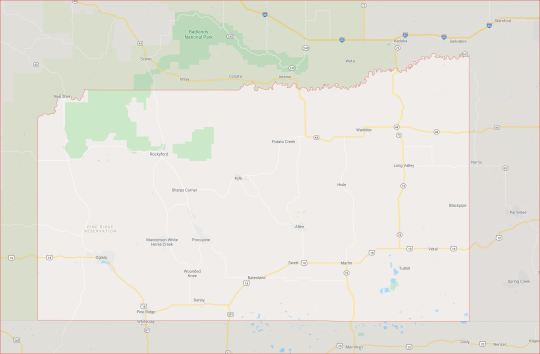
Direkt hinter Carter werden wir von einem Schild freundlich begrüßt: „Welcome to the Rosebud Indian Reservation“. Kurz darauf geht’s an einer Müllkippe vorbei. Der Highway West 18 ist in einem Top-Zustand. Wer es gern einsam mag, ist in diesem Reservat goldrichtig. Wir scheinen allein auf der Welt zu sein. Okreek, South Dakota, durchfahren wir zügig. Zwei Hunde laufen über die Straße. Bei starkem Verkehr wäre es ein lebensgefährliches Spiel mit dem Leben, bei dem geringen Verkehrsaufkommen ist es allerdings ein Paradies für die Tiere. Nach und nach wird es wieder hügeliger, interessante Gesteinsformationen nehmen zu. Aber die Natur hatte seinerzeit andere Pläne, denn es wird wieder flacher.
Erste Häuser und Trailer Homes deuten darauf hin, dass wir uns Mission, South Dakota, nähern. Die Vororte White Horse und Antelope sind schnell durchfahren. „Welcome to Mission“. Ein Schild fordert: „Support our troops“, ein anderes weist den Weg zur Sinte Gleska University, einer indianischen Universität. Mission ist ein schlichter Ort mit knapp 1000 Einwohnern im Todd County und die größte Gemeinde in der Rosebud Indian Reservation. Der Ort wurde nach Missionaren benannt, die sich zum Ende des 19. Jahrhunderts um die Sicangu-Lakota-Sioux „kümmerten“. Rund 85% der Einwohner sind Angehörige des Indianerstammes. Das Durchschnittsalter der Bevölkerung beträgt circa 23 Jahre, etwa 40 % davon sind unter 18 Jahre alt. Das Pro-Kopf-Einkommen ist mit etwas mehr als 11.000 Dollar im Jahr eines der niedrigsten Einkommen in den Vereinigten Staaten. So ist es kein Wunder, dass circa 30% der Bevölkerung unterhalb der Armutsgrenze leben und die Arbeitslosenquote über 80% beträgt. Mission ist der Sitz der Sinte Gleska University, der Stammes-Universität der Rosebud Reservation. Das Motto der Universität lautet: Wahope unglawa sakapi hecel oyate ki Wolakota gluha tokatakiya unya pi kte, was so viel heißt wie „Stärkung unserer Stiftung für die Menschen, damit sie auf dem Lakota-Weg vorwärts gehen können“. Die 1970 gegründete Sinte-Gleska-Universität (SGU) ist ein privates College für Indianerstämme im Rosebud Indianerreservat. Die SGU hat etwas mehr als 800 Studenten. Stammeshochschulen dienen indianischen Bevölkerungsgruppen, die keine andere Möglichkeit haben, Zugang zu höherer Bildung zu erhalten; sie sind auch ein Mittel für die Stämme, Fächer aus der Perspektive ihrer Kulturen zu unterrichten. In Mission befindet sich neben der Universität auch die High School vom Todd County.
Auf dem Weg nach Rosebud in South Dakota in der Rosebud Indian Reservation tauchen immer wieder Schilder am Straßenrand auf, die an die Verkehrstoten erinnern: „Why die?“ 10 Meilen bis Rosebud. Wir verlassen den Highway 18 und halten uns links auf den BIA Highway 1 und erreichen bald darauf die Hauptstadt der Reservation.
Rosebud ist eine indianische Siedlung im Todd County mit etwa 1500 Einwohnern. Sie ist die größte Siedlung im Reservat und Verwaltungssitz der Rosebud Indianer Reservation. Rosebud ist keine Gemeinde im Sinne des amerikanischen Rechts, sondern ein Census-designated place, ein 'Zu Statistikzwecken definiertes Siedlungsgebiet'. Fast 94 % der Einwohner sind Mitglieder des gleichnamigen Sioux Stammes.
Rosebud begrüßt die Besucher mit: „Welcome to the Land of the Sicangu Lakota Oyate“. Der Ort wird von standardisierten blassblau-grauen Holzhäusern geprägt. In der Nähe des Stadions befindet sich ein kleiner Markt, daneben dreht sich ein kleines Plastikriesenrad für Kinder. Die Toiletten der Tankstelle an der Hauptstraße sind wegen Vandalismus geschlossen. Die Indianer vor dem Tankstellenshop geben ein trauriges Bild ab, stehen dort wie ein Symbol des amerikanischen Albtraums.
Wir erreichen die Vororte von St. Francis, South Dakota, begrüßt von einem Wasserturm, eigentlich ein Symbol für Ansiedlungen der weißen US-Amerikaner. Hier ist alles ein wenig anders – auch die amerikanische Flagge flattert im Wind. Das eine oder andere Haus ist zugemüllt oder machen einen heruntergekommenen Eindruck. St. Francis ist eine Gemeinde mit etwa 700 Einwohnern im Todd County und gehört wie Rosebud ebenfalls zur Rosebud Indian Reservation. Zudem ist die Gemeinde Sitz der St. Francis Mission. St. Francis stellt einen Repräsentanten für das 'Rosebud Tribal Council', die Regierung der Reservation. Gegründet wurde St. Francis 1886 von katholischen Jesuiten, die im Reservat eine Schule errichteten. Die Gemeinde ist nach Franz von Assisi benannt. Über 90 % der Bevölkerung sind Angehörige der Indianerstämme. Das Durchschnittsalter beträgt 24 Jahre. In der unmittelbaren Umgebung von St. Francis wohnten um die 2.200 Personen. Fast 60 % der Bevölkerung leben in Armut. Ein Gebäudeblock erinnert an sozialen Wohnungsbau. Überall Verbotsschilder, vor allem Alkohol ist untersagt. Vorbei geht’s an der örtlichen Tankstelle und der Poststation. Rechts der Straße mähen Indianer Rasenflächen vor ihren schlichten Häusern.
Die St. Francis Mission und das Buechel Museum sind nicht zu verfehlen. Das Buechel Memorial Lakota Museum ist leider geschlossen, dafür hat die St. Charles Borromeo Catholic Kirche geöffnet. Schade, wir hätten uns im Museum gern die Sammlung mit über 2000 Artefakten über die Tradition, Kultur und Geschichte der Lakota angesehen. Wir erfahren, dass das Museum von Freiwilligen betreut wird, die Führungen durch das Museum und die historischen Kirchen der St.-Franziskus-Mission anbieten. Die St. Francis Mission ist eine 1886 gegründete gemeinnützige Organisation von Jesuiten, die immer noch das Ziel hat, die im Reservat lebenden Lakota (Sioux) zu evangelisieren. Damit ist die St. Francis Mission auch die größte gemeinnützige Organisation im Rosebud Reservat, die kein von der Regierung kontrolliertes oder finanziertes Programm durchführt. Die Charles Borromeo Catholic Church der St. Francis Mission ist insofern interessant, als sie von außen in grellem Hell-Lila gestrichen ist. Der unfreundliche Priester weist gerade zwei Indianerjungen als Messdiener ein, die völlig konsterniert dreinblicken.

Photo: Charles Borromeo Catholic Church
Wir kaufen einem Indianer einen kleinen 50×60 cm großen Teppich ab, der angeblich von seiner Großmutter gewebt wurde. Er hätte da auch noch … matt winken wir ab. Der Indianer wirkt verwahrlost und sieht völlig erschöpft aus.
St. Francis ist trotz der einiger baufälliger Häuser und zugemüllter Grundstücke ein recht idyllischer Ort mit jeder Menge grün blühender Bäume. Damit kein falscher Eindruck entsteht, wir wissen schon, dass wir das mit den Augen weißer Europäer betrachten und das man eine objektive Beschreibung der Zustände erst abgeben kann, wenn man hier leben würde.
Auf dem BIA Highway 501 verlassen wir St. Francis. Es geht noch einige Zeit an den Holz- oder Aluminiumhäusern der Indianer vorbei. Interessanterweise sind die Gebäude hier nicht so heruntergekommen wie in den Ansiedlungen zuvor. So scheint es jedenfalls aus der Ferne. Nochmal: Es sind unsere Synonyme „heruntergekommen, schön, nett, sauber“ und so weiter.
Braun-weiß gescheckte Indianerpferde grasen auf Weiden, Farmland sehen wir nicht. Mitten in den Great Plains fahren wir nun in eine bewaldete, sacht ansteigende Hügellandschaft. Dazwischen wird das Land teilweise landwirtschaftlich genutzt. Nach einiger Zeit erreichen wir auf dem BIA Highway 5 die Höhe eines Plateaus in etwa 1000 Metern Höhe über N/N und durchfahren bald darauf den wilden, einsamen Crazy Horse Canyon, offensichtlich ein beliebter Freizeitort. Der Little White River windet sich mit uns durch das Tal. Wir schauen von der Höhe runter in die eindrucksvollen grünen Täler mit kleinen Flüsschen. Obwohl die Natur hier oben weit zurück ist, zeigen sich an den Bäume gerade die ersten Knospen. Auf einem Grundstück stehen Unmengen von Waschmaschinen, ein surrealistisches Bild in dieser Bilderbuchlandschaft. Kaum zu glauben, aber auf einmal steht da ein Lama auf einer Wiese. Ein Pow-Wow-Platz liegt romantisch auf einer Waldlichtung, links leuchtet ein Tipi im Sonnenlicht. Auf dem BIA Highway 7 überqueren wir den Little White River über die Lampert Bridge, witzigerweise hat jemand die spanische Flagge gehisst.
Parmelee ist ein Ort mit etwa 650 überwiegend indianischen Einwohnern im Todd County in South Dakota, der noch innerhalb des Rosebud-Indianerreservats liegt. Die Ansiedlung wurde 1916 als Cut Meat gegründet und 1921 in Parmelee umbenannt. Fast 78% der Bevölkerung leben unterhalb der Armutsgrenze, darunter erschreckenderweise fast 85% der unter 18-Jährigen. An der Hauptstraße in Parmelee finden wir endlich eine Tankstelle. Die Bewohner des Ortes machen einen freundlichen Eindruck, viele junge Menschen sind auf den Beinen. Der Besitzer der Gas Station ist ein Weißer, die Indianer im Shop sind gut gelaunt. Ein Schild an der Kirche fordert: „Have Respect“. Hinter Parmelee liegen in karger Landschaft Felder brach, vereinzelt sehen wir Farmen, wie zum Beispiel die Emanuel Farm, die Rinderzucht betreibt. Kurz darauf verlassen wir die Reservation.
Norris ist eine lütte Gemeinde im Mellette County, South Dakota, die von knapp 150 Menschen bewohnt wird. Die Ansiedlung wurde 1910 gegründet. Ein Schild erinnert daran, dass man in den USA unterwegs ist: „United we stand. One Nation under God”. Die Sacred Heart Kirche mit einem grünen Dach steht einsam in der dürren Landschaft. In dem Örtchen wohnen nicht mehr als zwanzig Menschen, überwiegend Indianer. Am Straßenrand des South Dakota Highways 63 wartet ein Indianer, aha, und da stehen schon die hellblauen oder hellgrauen Häuser der Natives.
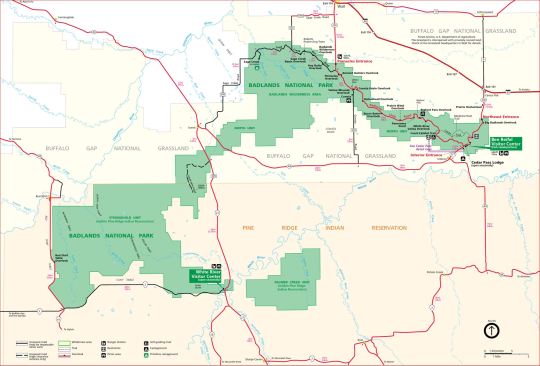
Die Weite der Felder ist in ihrer Monotonie bemerkenswert. Vereinzelt sehen wir Indianer, obwohl wir uns außerhalb der Reservate bewegen. Nach 11 Kilometern ist der Highway 63 nicht mehr asphaltiert, sondern eine Schotterstraße. Von Norris bis Belvidere stoppe ich alle hundert Meter unseren Bus, um die ungewöhnlichen Gesteinsformationen der Cedar Buttes zu bestaunen. Die Straße führt durch eine Landschaft mit wie von Außerirdischen geschaffenen Sandsteinformationen. Wir sehen bizarre Formationen, die wie aufgeschüttete Kaliberge wirken. Die halbtrockenen, sanften Hügel werden von groben Schluchten durchschnitten. Der Blick auf die grauen, zerklüfteten und skurrilen Formationen ist teilweise atemberaubend. Trockene Bäche schlängeln sich seitwärts durch die niedriger gelegenen und grün bedeckten Hügel. Die Felsen erinnern an riesige Haifischzähne, die glatten Sedimentpfeiler sind mit gelben Kaktusfeigen bedeckt. Mutterseelenallein fahren wir auf dem endlos braungrauen Band der 63, zwischen den Formationen weiden Tausende von Rindern. Rechts des Highways fließt der Black Pipe Creek. Ich muss an einen Artikel über den indianischen Ranger Richard Sherman, einem Mitglied des Oglala-Sioux-Stammes, denken, in dem Sherman von seinen Erfahrungen in Cedar Butte berichtet. Er beschreibt die psychischen Auswirkungen durch die Einsamkeit der Badlands, von den magischen Orten, vom Frieden und der Inspiration, die man in dieser Naturlandschaft findet. Der Ranger berichtet von seinen Wanderungen durch die Flora der Badlands und erwähnt die traditionelle Nutzung der Ess- und Heilpflanzen durch die Indianer. Eindrucksvoll beschreibt er die Stille der Landschaft, nur unterbrochen vom Wind, vom Geheul eines Kojoten oder von einem kreischenden Rotschwanzfalken. Sherman berichtet auch, dass Cedar Butte wahrscheinlich das wichtigste Zuchtgebiet für Dickhornschafe ist, die hier in den 1960er Jahren angesiedelt wurden und selbstverständlich erwähnt er auch, dass dieser Ort für die Indianer heilig war und immer noch ist. Für die Lakota ist alles heilig – das Land, der Tag, das Leben. Tja – besser kann man es nicht ausdrücken. Langsam verlassen wir Cedar Butte und Weideland mit Tausenden von Rindern dominiert nun das Terrain. Elke: Was für ein tolles Land. Wie recht sie hat.
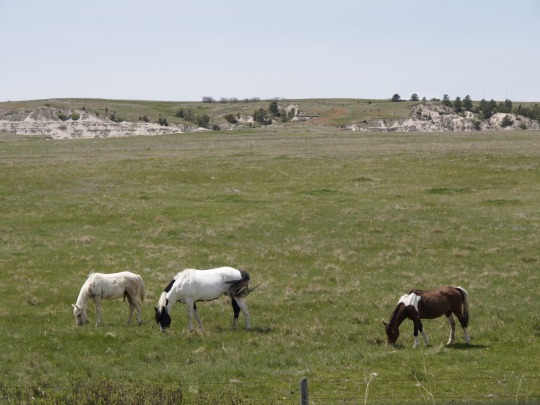
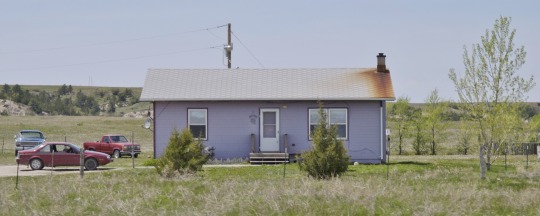
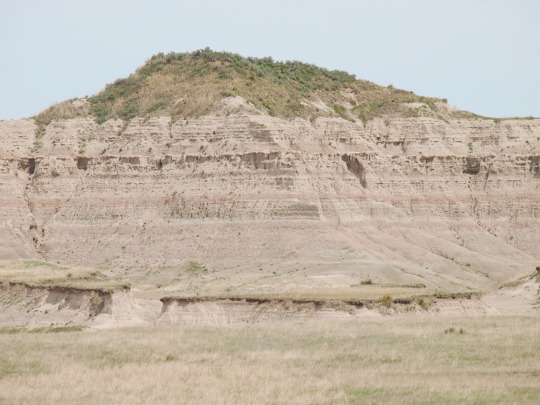
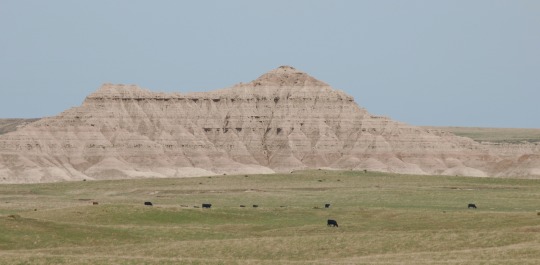
Photos: Impressionen on the State Route 63
Vor uns fließt der White River. Als wir einen Blick auf den Fluss werfen, kommen Hunderte von Schwalben angeflogen, piepen aufgeregt und umfliegen uns hektisch, um uns von ihren Nestern zu vertreiben, die sich unter der Flussbrücke befinden.

Foto: White River
Bei Belvidere, South Dakota, einem kleinen Nest mit etwa 60 Einwohnern, fahren wir auf der Nebenstrecker der Interstate 90 entspannt nach Kadoka, South Dakota, wo wir gegen 16 Uhr eintreffen. Die flache Gegend hier ist landschaftlich etwas langweilig. Weideflächen wohin man schaut. 1 Meile bis Süd-Kadoka. Aus der Ferne grüßt, in warmem Blau gehalten, der Wasserturm von Kadoka. Links steht die Rodeo Arena. Das Ortsschild Kadoka zeigt an, dass hier 736 Menschen leben. Für amerikanische Verhältnisse reicht das allemal aus, als Stadt bezeichnet zu werden. Natürlich fehlen auch nicht der obligatorische Gebrauchtwagenhändler und ein Schrottplatz. Links geht es zum Airport. Quartier beziehen wir im Budget Host Inn für 66 Dollar die Nacht. Ein netter Typ im Office erledigt den Check-In. Verblüfft starre ich ihn, denn er sieht original so aus wie der Musiker Sting. Kadoka liegt am östlichen Eingang des Buffalo Gap National Grassland und ist gleichzeitig die Eingangspforte zu den Badlands.
Nach einer kurzen Ruhepause besuchen wir ein kleines Restaurant, in dem wir den leckersten Hamburger unseres Lebens serviert bekommen. Den Abend lassen wir auf der Terrasse unseres Hotels ausklingen. Das Wetter in Kadoka ist anders als am Missouri River. Der Wetterbericht meldet für Morgen Temperaturen von bis zu 34 Grad Celsius.
#Maximilian Prinz zu Wied#karl bodmer#David Dreidoppel#Reise in das innere Nordamerika#Ulrich Schmotz#Dead End Reise in das Innere Nordamerikas#usa#Rosebud Indian Reservation (Lakota Sicangu Oyate) Black Hills#Snake Creek State Recreation Area South Dakota#Kadoka South Dakota
2 notes
·
View notes
Video
youtube
Bob Theil |Wind in the wires
0 notes
Text

Playlist; Astral Glamour fill, Triple R, December 28, 2020
Listen back on demand
Stanley Cowell - Travelin’ Man
Pharoah Sanders - Love Will Find A Way
Sun Ra - UFO (studio version)
Brother Ah - Transcendental March (Creation Song)
Sign Libra - Sea of Serenity
Andras - Poppy
Zon Vern Pyles - Rush Hour
Mariah - Sokokara
Shintaro Sakamoto - In A Phantom Mood
Cayn Borthwick - Keep Me
Bassline feat. Lorraine Chambers - You’ve Gone
Romolo Grano, Gianni Oddi - Kukumbe
Manu Dibango - Ceddo
Shankar Family & Friends - Lust (Raga Chandrakauns)
Conrad Schnitzler - Ballet Statique
Isla Cameron - O Willow Waly
Comus - In The Lost Queen’s Eyes
Kelsey Lu - Morning Dew
Maxine Funke - Through the Trees
Lehmann B. Smith - Letting Go
Sea Oleena - Will I Know
Ymistye (Misty) White - Come Again in November
Bob Theil - Who Are We Now
Colin Blunstone - Though You Are Far Away
Eden Ahbez - The Wanderer
Moondog - High on a Rocky Ledge
Roberta Flack - Do What You Gotta Do
0 notes
Photo
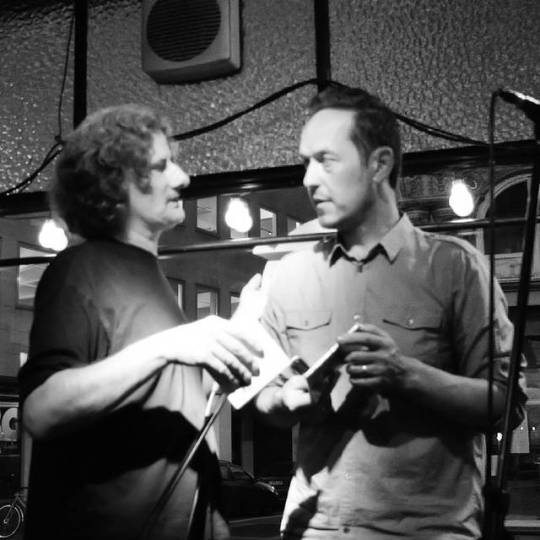
Swapping albums with the mighty Bob Theil (check him out!), August 2016 #bobtheil #folk #indiefolk #musicians #singersongwriter #cafeami #postgig #antwerp #antwerpen (at Cafe Ami Antwerpen)
1 note
·
View note
Text
From Contraband To Desired Brand
An industry with a projected worth of $50 billion by 2026, cannabis is poised to make huge gains in the lifestyle, health and wellness industries. Marijuana has fought hard to overcome stereotypes such as the stoner stigma made famous by Cheech and Chong. Yet as more states in the US legalize marijuana, and other countries continue to at least decriminalize it, cannabis is attracting interest among investors and industries alike. Noted trends forecaster, Gerald Celente of the Trends Institute, has been talking about this for years, going so far as to name it a top 10 trend for 2017. He cites opportunities aplenty that extend far beyond the traditional notions of the backstreet Amsterdam coffee house or dispensary. At this year’s SXSW, a panel of pioneering women in the cannabis industry shared an all-up view of the opportunities available especially for women and the 50-plus market.
Perception-Shifting Case
One of the more interesting factors in marijuana’s pivot to create highly-desired brands has been the influence of the tech industry. In April of 2015, Founders Fund, a venture capital firm co-founded by investor Peter Theil, made a multi-million dollar investment in Privateer Holdings, a Seattle company that manages several marijuana businesses. Among Privateer’s company is Leafy, a site that manages news and reviews, and Tilray, which researches and cultivates crops in Canada, and the Bob Marley official cannabis brand which includes the “rise up” social initiative and a line of body care products.
Brendan Kennedy, one of Privateer’s founders said in a NY Times interview, “After looking into the industry, we quickly realized that this is no longer, and hasn’t been for years, a countercultural product.” There was opportunity, he added, because “the brands that were out there tended to embrace the clichés of the industry.”
Another cliché that is being broken, according to Rustigian Burderer, founder of cannabis start-up Simplegentix, is the customer experience. By creating tastefully curated dispensaries that look more like polished, high-end retail stores, it’s easy to reach more customers. Campaign describes a San Francisco store, called Harvest, where consumers are welcomed into a modern retail environment that doesn’t scream marijuana. Instead, wooden shelves showcase products while posters describe its medical benefits. She says, “It’s indicative of how the industry is becoming more accepting. From the stoner, it’s developed into a sophisticated, elegant light.”
Evolving Opportunity
JWT Intelligence asks, “Can cannabis be the next beauty super ingredient?” SXSW panel speaker Emily Paxhia says, “I’m seeing more branded lifestyle products that address the different need states around cannabis, and it’s not about getting as high as humanly possible.” She points to Whoopi Goldberg’s Whoopi and Maya line of medical cannabis products that work to ease menstrual cramps, and are branded to look more like “high-end products you might come across in a department store.”
Beauty and wellness is a massively growing segment. In the last year and a half, executives from L’Oreal and Aveda have expressed interest in implementing cannabis in products. Some brands are infusing beauty products with cannabidiol (CBD), which is a non-psychoactive substance derived from plant. Since it lacks THC, the products can be classified as ‘legal hemp’ versus cannabis. This may contribute to even broader appeal, further destroying the old, outdated stigma.
The Trend Is Your Friend
In the age of disruption, very little is permanent. Some taboos, such as those surrounding cannabis, are eroding in the face of the growing body of science about its benefits. Other taboos as well – gender norms, womanhood, the definition of ‘a beautiful body’ — are meeting similar challenges in the marketplace of ideas. Brands that are stuck due to stigma can take a lesson from what is happening with the cannabis industry. By understanding the forces at work behind the all-up perception-shifting case, and working to implement fundamental changes based on those insights, it’s possible to leverage a trend to affect dramatic outcomes. Even better still, the beauty and wellness industry is removing the controversial aspects of the cannabis taboo (THC) and double-trend-dipping in both ingredient and lifestyle.
The Blake Project Can Help: The Brand Positioning Workshop
Branding Strategy Insider is a service of The Blake Project: A strategic brand consultancy specializing in Brand Research, Brand Strategy, Brand Licensing and Brand Education
FREE Publications And Resources For Marketers
0 notes
Text
From Contraband To Desired Brand
An industry with a projected worth of $50 billion by 2026, cannabis is poised to make huge gains in the lifestyle, health and wellness industries. Marijuana has fought hard to overcome stereotypes such as the stoner stigma made famous by Cheech and Chong. Yet as more states in the US legalize marijuana, and other countries continue to at least decriminalize it, cannabis is attracting interest among investors and industries alike. Noted trends forecaster, Gerald Celente of the Trends Institute, has been talking about this for years, going so far as to name it a top 10 trend for 2017. He cites opportunities aplenty that extend far beyond the traditional notions of the backstreet Amsterdam coffee house or dispensary. At this year’s SXSW, a panel of pioneering women in the cannabis industry shared an all-up view of the opportunities available especially for women and the 50-plus market.
Perception-Shifting Case
One of the more interesting factors in marijuana’s pivot to create highly-desired brands has been the influence of the tech industry. In April of 2015, Founders Fund, a venture capital firm co-founded by investor Peter Theil, made a multi-million dollar investment in Privateer Holdings, a Seattle company that manages several marijuana businesses. Among Privateer’s company is Leafy, a site that manages news and reviews, and Tilray, which researches and cultivates crops in Canada, and the Bob Marley official cannabis brand which includes the “rise up” social initiative and a line of body care products.
Brendan Kennedy, one of Privateer’s founders said in a NY Times interview, “After looking into the industry, we quickly realized that this is no longer, and hasn’t been for years, a countercultural product.” There was opportunity, he added, because “the brands that were out there tended to embrace the clichés of the industry.”
Another cliché that is being broken, according to Rustigian Burderer, founder of cannabis start-up Simplegentix, is the customer experience. By creating tastefully curated dispensaries that look more like polished, high-end retail stores, it’s easy to reach more customers. Campaign describes a San Francisco store, called Harvest, where consumers are welcomed into a modern retail environment that doesn’t scream marijuana. Instead, wooden shelves showcase products while posters describe its medical benefits. She says, “It’s indicative of how the industry is becoming more accepting. From the stoner, it’s developed into a sophisticated, elegant light.”
Evolving Opportunity
JWT Intelligence asks, “Can cannabis be the next beauty super ingredient?” SXSW panel speaker Emily Paxhia says, “I’m seeing more branded lifestyle products that address the different need states around cannabis, and it’s not about getting as high as humanly possible.” She points to Whoopi Goldberg’s Whoopi and Maya line of medical cannabis products that work to ease menstrual cramps, and are branded to look more like “high-end products you might come across in a department store.”
Beauty and wellness is a massively growing segment. In the last year and a half, executives from L’Oreal and Aveda have expressed interest in implementing cannabis in products. Some brands are infusing beauty products with cannabidiol (CBD), which is a non-psychoactive substance derived from plant. Since it lacks THC, the products can be classified as ‘legal hemp’ versus cannabis. This may contribute to even broader appeal, further destroying the old, outdated stigma.
The Trend Is Your Friend
In the age of disruption, very little is permanent. Some taboos, such as those surrounding cannabis, are eroding in the face of the growing body of science about its benefits. Other taboos as well – gender norms, womanhood, the definition of ‘a beautiful body’ — are meeting similar challenges in the marketplace of ideas. Brands that are stuck due to stigma can take a lesson from what is happening with the cannabis industry. By understanding the forces at work behind the all-up perception-shifting case, and working to implement fundamental changes based on those insights, it’s possible to leverage a trend to affect dramatic outcomes. Even better still, the beauty and wellness industry is removing the controversial aspects of the cannabis taboo (THC) and double-trend-dipping in both ingredient and lifestyle.
The Blake Project Can Help: The Brand Positioning Workshop
Branding Strategy Insider is a service of The Blake Project: A strategic brand consultancy specializing in Brand Research, Brand Strategy, Brand Licensing and Brand Education
FREE Publications And Resources For Marketers
via WordPress http://ift.tt/2ttEhDU
via WordPress http://ift.tt/2rCyVVD
via WordPress http://ift.tt/2rCALFD
via WordPress http://ift.tt/2sw3Y9r
via WordPress http://ift.tt/2t8y0Ov
via WordPress http://ift.tt/2t91wns
via WordPress http://ift.tt/2sFUUj0
via WordPress http://ift.tt/2rxR1N9
via WordPress http://ift.tt/2rCxMgo
via WordPress http://ift.tt/2tu2fP4
via WordPress http://ift.tt/2shs2ea
via WordPress http://ift.tt/2ttZX2H
via WordPress http://ift.tt/2rxWfsm
via WordPress http://ift.tt/2sFSgcQ
via WordPress http://ift.tt/2s82lOM
via WordPress http://ift.tt/2rCErHK
via WordPress http://ift.tt/2ttL40b
via WordPress http://ift.tt/2rydfPf
via WordPress http://ift.tt/2rn6viJ
via WordPress http://ift.tt/2s85Ch0
via WordPress http://ift.tt/2ttTR2b
via WordPress http://ift.tt/2s8bdnB
via WordPress http://ift.tt/2t9cMQx
via WordPress http://ift.tt/2tu8WB1
via WordPress http://ift.tt/2sG8J0V
via WordPress http://ift.tt/2rDcVty
via WordPress http://ift.tt/2rD2Mgt
via WordPress http://ift.tt/2swFjS3
via WordPress http://ift.tt/2s8tAIV
via WordPress http://ift.tt/2rDFDdL
via WordPress http://ift.tt/2s8KmHR
via WordPress http://ift.tt/2s8KMOy
via WordPress http://ift.tt/2rDzoGI
via WordPress http://ift.tt/2rDUe9j
via WordPress http://ift.tt/2t9Q6zB
via WordPress http://ift.tt/2ro0m63
via WordPress http://ift.tt/2sjJ3Vf
from WordPress http://ift.tt/2tw3vRT via IFTTT
0 notes
Text
From Contraband To Desired Brand
An industry with a projected worth of $50 billion by 2026, cannabis is poised to make huge gains in the lifestyle, health and wellness industries. Marijuana has fought hard to overcome stereotypes such as the stoner stigma made famous by Cheech and Chong. Yet as more states in the US legalize marijuana, and other countries continue to at least decriminalize it, cannabis is attracting interest among investors and industries alike. Noted trends forecaster, Gerald Celente of the Trends Institute, has been talking about this for years, going so far as to name it a top 10 trend for 2017. He cites opportunities aplenty that extend far beyond the traditional notions of the backstreet Amsterdam coffee house or dispensary. At this year’s SXSW, a panel of pioneering women in the cannabis industry shared an all-up view of the opportunities available especially for women and the 50-plus market.
Perception-Shifting Case
One of the more interesting factors in marijuana’s pivot to create highly-desired brands has been the influence of the tech industry. In April of 2015, Founders Fund, a venture capital firm co-founded by investor Peter Theil, made a multi-million dollar investment in Privateer Holdings, a Seattle company that manages several marijuana businesses. Among Privateer’s company is Leafy, a site that manages news and reviews, and Tilray, which researches and cultivates crops in Canada, and the Bob Marley official cannabis brand which includes the “rise up” social initiative and a line of body care products.
Brendan Kennedy, one of Privateer’s founders said in a NY Times interview, “After looking into the industry, we quickly realized that this is no longer, and hasn’t been for years, a countercultural product.” There was opportunity, he added, because “the brands that were out there tended to embrace the clichés of the industry.”
Another cliché that is being broken, according to Rustigian Burderer, founder of cannabis start-up Simplegentix, is the customer experience. By creating tastefully curated dispensaries that look more like polished, high-end retail stores, it’s easy to reach more customers. Campaign describes a San Francisco store, called Harvest, where consumers are welcomed into a modern retail environment that doesn’t scream marijuana. Instead, wooden shelves showcase products while posters describe its medical benefits. She says, “It’s indicative of how the industry is becoming more accepting. From the stoner, it’s developed into a sophisticated, elegant light.”
Evolving Opportunity
JWT Intelligence asks, “Can cannabis be the next beauty super ingredient?” SXSW panel speaker Emily Paxhia says, “I’m seeing more branded lifestyle products that address the different need states around cannabis, and it’s not about getting as high as humanly possible.” She points to Whoopi Goldberg’s Whoopi and Maya line of medical cannabis products that work to ease menstrual cramps, and are branded to look more like “high-end products you might come across in a department store.”
Beauty and wellness is a massively growing segment. In the last year and a half, executives from L’Oreal and Aveda have expressed interest in implementing cannabis in products. Some brands are infusing beauty products with cannabidiol (CBD), which is a non-psychoactive substance derived from plant. Since it lacks THC, the products can be classified as ‘legal hemp’ versus cannabis. This may contribute to even broader appeal, further destroying the old, outdated stigma.
The Trend Is Your Friend
In the age of disruption, very little is permanent. Some taboos, such as those surrounding cannabis, are eroding in the face of the growing body of science about its benefits. Other taboos as well – gender norms, womanhood, the definition of ‘a beautiful body’ — are meeting similar challenges in the marketplace of ideas. Brands that are stuck due to stigma can take a lesson from what is happening with the cannabis industry. By understanding the forces at work behind the all-up perception-shifting case, and working to implement fundamental changes based on those insights, it’s possible to leverage a trend to affect dramatic outcomes. Even better still, the beauty and wellness industry is removing the controversial aspects of the cannabis taboo (THC) and double-trend-dipping in both ingredient and lifestyle.
The Blake Project Can Help: The Brand Positioning Workshop
Branding Strategy Insider is a service of The Blake Project: A strategic brand consultancy specializing in Brand Research, Brand Strategy, Brand Licensing and Brand Education
FREE Publications And Resources For Marketers
0 notes
Text
From Contraband To Desired Brand
An industry with a projected worth of $50 billion by 2026, cannabis is poised to make huge gains in the lifestyle, health and wellness industries. Marijuana has fought hard to overcome stereotypes such as the stoner stigma made famous by Cheech and Chong. Yet as more states in the US legalize marijuana, and other countries continue to at least decriminalize it, cannabis is attracting interest among investors and industries alike. Noted trends forecaster, Gerald Celente of the Trends Institute, has been talking about this for years, going so far as to name it a top 10 trend for 2017. He cites opportunities aplenty that extend far beyond the traditional notions of the backstreet Amsterdam coffee house or dispensary. At this year’s SXSW, a panel of pioneering women in the cannabis industry shared an all-up view of the opportunities available especially for women and the 50-plus market.
Perception-Shifting Case
One of the more interesting factors in marijuana’s pivot to create highly-desired brands has been the influence of the tech industry. In April of 2015, Founders Fund, a venture capital firm co-founded by investor Peter Theil, made a multi-million dollar investment in Privateer Holdings, a Seattle company that manages several marijuana businesses. Among Privateer’s company is Leafy, a site that manages news and reviews, and Tilray, which researches and cultivates crops in Canada, and the Bob Marley official cannabis brand which includes the “rise up” social initiative and a line of body care products.
Brendan Kennedy, one of Privateer’s founders said in a NY Times interview, “After looking into the industry, we quickly realized that this is no longer, and hasn’t been for years, a countercultural product.” There was opportunity, he added, because “the brands that were out there tended to embrace the clichés of the industry.”
Another cliché that is being broken, according to Rustigian Burderer, founder of cannabis start-up Simplegentix, is the customer experience. By creating tastefully curated dispensaries that look more like polished, high-end retail stores, it’s easy to reach more customers. Campaign describes a San Francisco store, called Harvest, where consumers are welcomed into a modern retail environment that doesn’t scream marijuana. Instead, wooden shelves showcase products while posters describe its medical benefits. She says, “It’s indicative of how the industry is becoming more accepting. From the stoner, it’s developed into a sophisticated, elegant light.”
Evolving Opportunity
JWT Intelligence asks, “Can cannabis be the next beauty super ingredient?” SXSW panel speaker Emily Paxhia says, “I’m seeing more branded lifestyle products that address the different need states around cannabis, and it’s not about getting as high as humanly possible.” She points to Whoopi Goldberg’s Whoopi and Maya line of medical cannabis products that work to ease menstrual cramps, and are branded to look more like “high-end products you might come across in a department store.”
Beauty and wellness is a massively growing segment. In the last year and a half, executives from L’Oreal and Aveda have expressed interest in implementing cannabis in products. Some brands are infusing beauty products with cannabidiol (CBD), which is a non-psychoactive substance derived from plant. Since it lacks THC, the products can be classified as ‘legal hemp’ versus cannabis. This may contribute to even broader appeal, further destroying the old, outdated stigma.
The Trend Is Your Friend
In the age of disruption, very little is permanent. Some taboos, such as those surrounding cannabis, are eroding in the face of the growing body of science about its benefits. Other taboos as well – gender norms, womanhood, the definition of ‘a beautiful body’ — are meeting similar challenges in the marketplace of ideas. Brands that are stuck due to stigma can take a lesson from what is happening with the cannabis industry. By understanding the forces at work behind the all-up perception-shifting case, and working to implement fundamental changes based on those insights, it’s possible to leverage a trend to affect dramatic outcomes. Even better still, the beauty and wellness industry is removing the controversial aspects of the cannabis taboo (THC) and double-trend-dipping in both ingredient and lifestyle.
The Blake Project Can Help: The Brand Positioning Workshop
Branding Strategy Insider is a service of The Blake Project: A strategic brand consultancy specializing in Brand Research, Brand Strategy, Brand Licensing and Brand Education
FREE Publications And Resources For Marketers
0 notes
Text
From Contraband To Desired Brand
An industry with a projected worth of $50 billion by 2026, cannabis is poised to make huge gains in the lifestyle, health and wellness industries. Marijuana has fought hard to overcome stereotypes such as the stoner stigma made famous by Cheech and Chong. Yet as more states in the US legalize marijuana, and other countries continue to at least decriminalize it, cannabis is attracting interest among investors and industries alike. Noted trends forecaster, Gerald Celente of the Trends Institute, has been talking about this for years, going so far as to name it a top 10 trend for 2017. He cites opportunities aplenty that extend far beyond the traditional notions of the backstreet Amsterdam coffee house or dispensary. At this year’s SXSW, a panel of pioneering women in the cannabis industry shared an all-up view of the opportunities available especially for women and the 50-plus market.
Perception-Shifting Case
One of the more interesting factors in marijuana’s pivot to create highly-desired brands has been the influence of the tech industry. In April of 2015, Founders Fund, a venture capital firm co-founded by investor Peter Theil, made a multi-million dollar investment in Privateer Holdings, a Seattle company that manages several marijuana businesses. Among Privateer’s company is Leafy, a site that manages news and reviews, and Tilray, which researches and cultivates crops in Canada, and the Bob Marley official cannabis brand which includes the “rise up” social initiative and a line of body care products.
Brendan Kennedy, one of Privateer’s founders said in a NY Times interview, “After looking into the industry, we quickly realized that this is no longer, and hasn’t been for years, a countercultural product.” There was opportunity, he added, because “the brands that were out there tended to embrace the clichés of the industry.”
Another cliché that is being broken, according to Rustigian Burderer, founder of cannabis start-up Simplegentix, is the customer experience. By creating tastefully curated dispensaries that look more like polished, high-end retail stores, it’s easy to reach more customers. Campaign describes a San Francisco store, called Harvest, where consumers are welcomed into a modern retail environment that doesn’t scream marijuana. Instead, wooden shelves showcase products while posters describe its medical benefits. She says, “It’s indicative of how the industry is becoming more accepting. From the stoner, it’s developed into a sophisticated, elegant light.”
Evolving Opportunity
JWT Intelligence asks, “Can cannabis be the next beauty super ingredient?” SXSW panel speaker Emily Paxhia says, “I’m seeing more branded lifestyle products that address the different need states around cannabis, and it’s not about getting as high as humanly possible.” She points to Whoopi Goldberg’s Whoopi and Maya line of medical cannabis products that work to ease menstrual cramps, and are branded to look more like “high-end products you might come across in a department store.”
Beauty and wellness is a massively growing segment. In the last year and a half, executives from L’Oreal and Aveda have expressed interest in implementing cannabis in products. Some brands are infusing beauty products with cannabidiol (CBD), which is a non-psychoactive substance derived from plant. Since it lacks THC, the products can be classified as ‘legal hemp’ versus cannabis. This may contribute to even broader appeal, further destroying the old, outdated stigma.
The Trend Is Your Friend
In the age of disruption, very little is permanent. Some taboos, such as those surrounding cannabis, are eroding in the face of the growing body of science about its benefits. Other taboos as well – gender norms, womanhood, the definition of ‘a beautiful body’ — are meeting similar challenges in the marketplace of ideas. Brands that are stuck due to stigma can take a lesson from what is happening with the cannabis industry. By understanding the forces at work behind the all-up perception-shifting case, and working to implement fundamental changes based on those insights, it’s possible to leverage a trend to affect dramatic outcomes. Even better still, the beauty and wellness industry is removing the controversial aspects of the cannabis taboo (THC) and double-trend-dipping in both ingredient and lifestyle.
The Blake Project Can Help: The Brand Positioning Workshop
Branding Strategy Insider is a service of The Blake Project: A strategic brand consultancy specializing in Brand Research, Brand Strategy, Brand Licensing and Brand Education
FREE Publications And Resources For Marketers
0 notes
Text
From Contraband To Desired Brand
An industry with a projected worth of $50 billion by 2026, cannabis is poised to make huge gains in the lifestyle, health and wellness industries. Marijuana has fought hard to overcome stereotypes such as the stoner stigma made famous by Cheech and Chong. Yet as more states in the US legalize marijuana, and other countries continue to at least decriminalize it, cannabis is attracting interest among investors and industries alike. Noted trends forecaster, Gerald Celente of the Trends Institute, has been talking about this for years, going so far as to name it a top 10 trend for 2017. He cites opportunities aplenty that extend far beyond the traditional notions of the backstreet Amsterdam coffee house or dispensary. At this year’s SXSW, a panel of pioneering women in the cannabis industry shared an all-up view of the opportunities available especially for women and the 50-plus market.
Perception-Shifting Case
One of the more interesting factors in marijuana’s pivot to create highly-desired brands has been the influence of the tech industry. In April of 2015, Founders Fund, a venture capital firm co-founded by investor Peter Theil, made a multi-million dollar investment in Privateer Holdings, a Seattle company that manages several marijuana businesses. Among Privateer’s company is Leafy, a site that manages news and reviews, and Tilray, which researches and cultivates crops in Canada, and the Bob Marley official cannabis brand which includes the “rise up” social initiative and a line of body care products.
Brendan Kennedy, one of Privateer’s founders said in a NY Times interview, “After looking into the industry, we quickly realized that this is no longer, and hasn’t been for years, a countercultural product.” There was opportunity, he added, because “the brands that were out there tended to embrace the clichés of the industry.”
Another cliché that is being broken, according to Rustigian Burderer, founder of cannabis start-up Simplegentix, is the customer experience. By creating tastefully curated dispensaries that look more like polished, high-end retail stores, it’s easy to reach more customers. Campaign describes a San Francisco store, called Harvest, where consumers are welcomed into a modern retail environment that doesn’t scream marijuana. Instead, wooden shelves showcase products while posters describe its medical benefits. She says, “It’s indicative of how the industry is becoming more accepting. From the stoner, it’s developed into a sophisticated, elegant light.”
Evolving Opportunity
JWT Intelligence asks, “Can cannabis be the next beauty super ingredient?” SXSW panel speaker Emily Paxhia says, “I’m seeing more branded lifestyle products that address the different need states around cannabis, and it’s not about getting as high as humanly possible.” She points to Whoopi Goldberg’s Whoopi and Maya line of medical cannabis products that work to ease menstrual cramps, and are branded to look more like “high-end products you might come across in a department store.”
Beauty and wellness is a massively growing segment. In the last year and a half, executives from L’Oreal and Aveda have expressed interest in implementing cannabis in products. Some brands are infusing beauty products with cannabidiol (CBD), which is a non-psychoactive substance derived from plant. Since it lacks THC, the products can be classified as ‘legal hemp’ versus cannabis. This may contribute to even broader appeal, further destroying the old, outdated stigma.
The Trend Is Your Friend
In the age of disruption, very little is permanent. Some taboos, such as those surrounding cannabis, are eroding in the face of the growing body of science about its benefits. Other taboos as well – gender norms, womanhood, the definition of ‘a beautiful body’ — are meeting similar challenges in the marketplace of ideas. Brands that are stuck due to stigma can take a lesson from what is happening with the cannabis industry. By understanding the forces at work behind the all-up perception-shifting case, and working to implement fundamental changes based on those insights, it’s possible to leverage a trend to affect dramatic outcomes. Even better still, the beauty and wellness industry is removing the controversial aspects of the cannabis taboo (THC) and double-trend-dipping in both ingredient and lifestyle.
The Blake Project Can Help: The Brand Positioning Workshop
Branding Strategy Insider is a service of The Blake Project: A strategic brand consultancy specializing in Brand Research, Brand Strategy, Brand Licensing and Brand Education
FREE Publications And Resources For Marketers
0 notes
Text
From Contraband To Desired Brand
An industry with a projected worth of $50 billion by 2026, cannabis is poised to make huge gains in the lifestyle, health and wellness industries. Marijuana has fought hard to overcome stereotypes such as the stoner stigma made famous by Cheech and Chong. Yet as more states in the US legalize marijuana, and other countries continue to at least decriminalize it, cannabis is attracting interest among investors and industries alike. Noted trends forecaster, Gerald Celente of the Trends Institute, has been talking about this for years, going so far as to name it a top 10 trend for 2017. He cites opportunities aplenty that extend far beyond the traditional notions of the backstreet Amsterdam coffee house or dispensary. At this year’s SXSW, a panel of pioneering women in the cannabis industry shared an all-up view of the opportunities available especially for women and the 50-plus market.
Perception-Shifting Case
One of the more interesting factors in marijuana’s pivot to create highly-desired brands has been the influence of the tech industry. In April of 2015, Founders Fund, a venture capital firm co-founded by investor Peter Theil, made a multi-million dollar investment in Privateer Holdings, a Seattle company that manages several marijuana businesses. Among Privateer’s company is Leafy, a site that manages news and reviews, and Tilray, which researches and cultivates crops in Canada, and the Bob Marley official cannabis brand which includes the “rise up” social initiative and a line of body care products.
Brendan Kennedy, one of Privateer’s founders said in a NY Times interview, “After looking into the industry, we quickly realized that this is no longer, and hasn’t been for years, a countercultural product.” There was opportunity, he added, because “the brands that were out there tended to embrace the clichés of the industry.”
Another cliché that is being broken, according to Rustigian Burderer, founder of cannabis start-up Simplegentix, is the customer experience. By creating tastefully curated dispensaries that look more like polished, high-end retail stores, it’s easy to reach more customers. Campaign describes a San Francisco store, called Harvest, where consumers are welcomed into a modern retail environment that doesn’t scream marijuana. Instead, wooden shelves showcase products while posters describe its medical benefits. She says, “It’s indicative of how the industry is becoming more accepting. From the stoner, it’s developed into a sophisticated, elegant light.”
Evolving Opportunity
JWT Intelligence asks, “Can cannabis be the next beauty super ingredient?” SXSW panel speaker Emily Paxhia says, “I’m seeing more branded lifestyle products that address the different need states around cannabis, and it’s not about getting as high as humanly possible.” She points to Whoopi Goldberg’s Whoopi and Maya line of medical cannabis products that work to ease menstrual cramps, and are branded to look more like “high-end products you might come across in a department store.”
Beauty and wellness is a massively growing segment. In the last year and a half, executives from L’Oreal and Aveda have expressed interest in implementing cannabis in products. Some brands are infusing beauty products with cannabidiol (CBD), which is a non-psychoactive substance derived from plant. Since it lacks THC, the products can be classified as ‘legal hemp’ versus cannabis. This may contribute to even broader appeal, further destroying the old, outdated stigma.
The Trend Is Your Friend
In the age of disruption, very little is permanent. Some taboos, such as those surrounding cannabis, are eroding in the face of the growing body of science about its benefits. Other taboos as well – gender norms, womanhood, the definition of ‘a beautiful body’ — are meeting similar challenges in the marketplace of ideas. Brands that are stuck due to stigma can take a lesson from what is happening with the cannabis industry. By understanding the forces at work behind the all-up perception-shifting case, and working to implement fundamental changes based on those insights, it’s possible to leverage a trend to affect dramatic outcomes. Even better still, the beauty and wellness industry is removing the controversial aspects of the cannabis taboo (THC) and double-trend-dipping in both ingredient and lifestyle.
The Blake Project Can Help: The Brand Positioning Workshop
Branding Strategy Insider is a service of The Blake Project: A strategic brand consultancy specializing in Brand Research, Brand Strategy, Brand Licensing and Brand Education
FREE Publications And Resources For Marketers
0 notes
Text
From Contraband To Desired Brand
An industry with a projected worth of $50 billion by 2026, cannabis is poised to make huge gains in the lifestyle, health and wellness industries. Marijuana has fought hard to overcome stereotypes such as the stoner stigma made famous by Cheech and Chong. Yet as more states in the US legalize marijuana, and other countries continue to at least decriminalize it, cannabis is attracting interest among investors and industries alike. Noted trends forecaster, Gerald Celente of the Trends Institute, has been talking about this for years, going so far as to name it a top 10 trend for 2017. He cites opportunities aplenty that extend far beyond the traditional notions of the backstreet Amsterdam coffee house or dispensary. At this year’s SXSW, a panel of pioneering women in the cannabis industry shared an all-up view of the opportunities available especially for women and the 50-plus market.
Perception-Shifting Case
One of the more interesting factors in marijuana’s pivot to create highly-desired brands has been the influence of the tech industry. In April of 2015, Founders Fund, a venture capital firm co-founded by investor Peter Theil, made a multi-million dollar investment in Privateer Holdings, a Seattle company that manages several marijuana businesses. Among Privateer’s company is Leafy, a site that manages news and reviews, and Tilray, which researches and cultivates crops in Canada, and the Bob Marley official cannabis brand which includes the “rise up” social initiative and a line of body care products.
Brendan Kennedy, one of Privateer’s founders said in a NY Times interview, “After looking into the industry, we quickly realized that this is no longer, and hasn’t been for years, a countercultural product.” There was opportunity, he added, because “the brands that were out there tended to embrace the clichés of the industry.”
Another cliché that is being broken, according to Rustigian Burderer, founder of cannabis start-up Simplegentix, is the customer experience. By creating tastefully curated dispensaries that look more like polished, high-end retail stores, it’s easy to reach more customers. Campaign describes a San Francisco store, called Harvest, where consumers are welcomed into a modern retail environment that doesn’t scream marijuana. Instead, wooden shelves showcase products while posters describe its medical benefits. She says, “It’s indicative of how the industry is becoming more accepting. From the stoner, it’s developed into a sophisticated, elegant light.”
Evolving Opportunity
JWT Intelligence asks, “Can cannabis be the next beauty super ingredient?” SXSW panel speaker Emily Paxhia says, “I’m seeing more branded lifestyle products that address the different need states around cannabis, and it’s not about getting as high as humanly possible.” She points to Whoopi Goldberg’s Whoopi and Maya line of medical cannabis products that work to ease menstrual cramps, and are branded to look more like “high-end products you might come across in a department store.”
Beauty and wellness is a massively growing segment. In the last year and a half, executives from L’Oreal and Aveda have expressed interest in implementing cannabis in products. Some brands are infusing beauty products with cannabidiol (CBD), which is a non-psychoactive substance derived from plant. Since it lacks THC, the products can be classified as ‘legal hemp’ versus cannabis. This may contribute to even broader appeal, further destroying the old, outdated stigma.
The Trend Is Your Friend
In the age of disruption, very little is permanent. Some taboos, such as those surrounding cannabis, are eroding in the face of the growing body of science about its benefits. Other taboos as well – gender norms, womanhood, the definition of ‘a beautiful body’ — are meeting similar challenges in the marketplace of ideas. Brands that are stuck due to stigma can take a lesson from what is happening with the cannabis industry. By understanding the forces at work behind the all-up perception-shifting case, and working to implement fundamental changes based on those insights, it’s possible to leverage a trend to affect dramatic outcomes. Even better still, the beauty and wellness industry is removing the controversial aspects of the cannabis taboo (THC) and double-trend-dipping in both ingredient and lifestyle.
The Blake Project Can Help: The Brand Positioning Workshop
Branding Strategy Insider is a service of The Blake Project: A strategic brand consultancy specializing in Brand Research, Brand Strategy, Brand Licensing and Brand Education
FREE Publications And Resources For Marketers
0 notes
Text
From Contraband To Desired Brand
An industry with a projected worth of $50 billion by 2026, cannabis is poised to make huge gains in the lifestyle, health and wellness industries. Marijuana has fought hard to overcome stereotypes such as the stoner stigma made famous by Cheech and Chong. Yet as more states in the US legalize marijuana, and other countries continue to at least decriminalize it, cannabis is attracting interest among investors and industries alike. Noted trends forecaster, Gerald Celente of the Trends Institute, has been talking about this for years, going so far as to name it a top 10 trend for 2017. He cites opportunities aplenty that extend far beyond the traditional notions of the backstreet Amsterdam coffee house or dispensary. At this year’s SXSW, a panel of pioneering women in the cannabis industry shared an all-up view of the opportunities available especially for women and the 50-plus market.
Perception-Shifting Case
One of the more interesting factors in marijuana’s pivot to create highly-desired brands has been the influence of the tech industry. In April of 2015, Founders Fund, a venture capital firm co-founded by investor Peter Theil, made a multi-million dollar investment in Privateer Holdings, a Seattle company that manages several marijuana businesses. Among Privateer’s company is Leafy, a site that manages news and reviews, and Tilray, which researches and cultivates crops in Canada, and the Bob Marley official cannabis brand which includes the “rise up” social initiative and a line of body care products.
Brendan Kennedy, one of Privateer’s founders said in a NY Times interview, “After looking into the industry, we quickly realized that this is no longer, and hasn’t been for years, a countercultural product.” There was opportunity, he added, because “the brands that were out there tended to embrace the clichés of the industry.”
Another cliché that is being broken, according to Rustigian Burderer, founder of cannabis start-up Simplegentix, is the customer experience. By creating tastefully curated dispensaries that look more like polished, high-end retail stores, it’s easy to reach more customers. Campaign describes a San Francisco store, called Harvest, where consumers are welcomed into a modern retail environment that doesn’t scream marijuana. Instead, wooden shelves showcase products while posters describe its medical benefits. She says, “It’s indicative of how the industry is becoming more accepting. From the stoner, it’s developed into a sophisticated, elegant light.”
Evolving Opportunity
JWT Intelligence asks, “Can cannabis be the next beauty super ingredient?” SXSW panel speaker Emily Paxhia says, “I’m seeing more branded lifestyle products that address the different need states around cannabis, and it’s not about getting as high as humanly possible.” She points to Whoopi Goldberg’s Whoopi and Maya line of medical cannabis products that work to ease menstrual cramps, and are branded to look more like “high-end products you might come across in a department store.”
Beauty and wellness is a massively growing segment. In the last year and a half, executives from L’Oreal and Aveda have expressed interest in implementing cannabis in products. Some brands are infusing beauty products with cannabidiol (CBD), which is a non-psychoactive substance derived from plant. Since it lacks THC, the products can be classified as ‘legal hemp’ versus cannabis. This may contribute to even broader appeal, further destroying the old, outdated stigma.
The Trend Is Your Friend
In the age of disruption, very little is permanent. Some taboos, such as those surrounding cannabis, are eroding in the face of the growing body of science about its benefits. Other taboos as well – gender norms, womanhood, the definition of ‘a beautiful body’ — are meeting similar challenges in the marketplace of ideas. Brands that are stuck due to stigma can take a lesson from what is happening with the cannabis industry. By understanding the forces at work behind the all-up perception-shifting case, and working to implement fundamental changes based on those insights, it’s possible to leverage a trend to affect dramatic outcomes. Even better still, the beauty and wellness industry is removing the controversial aspects of the cannabis taboo (THC) and double-trend-dipping in both ingredient and lifestyle.
The Blake Project Can Help: The Brand Positioning Workshop
Branding Strategy Insider is a service of The Blake Project: A strategic brand consultancy specializing in Brand Research, Brand Strategy, Brand Licensing and Brand Education
FREE Publications And Resources For Marketers
0 notes